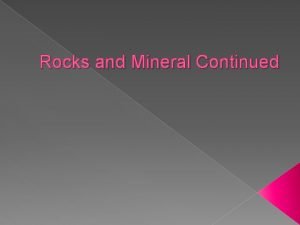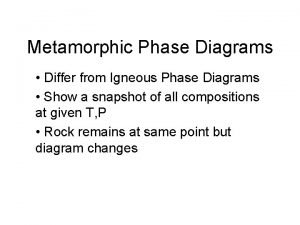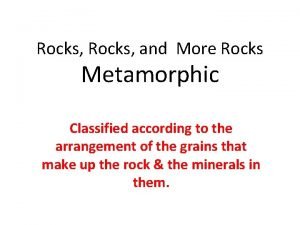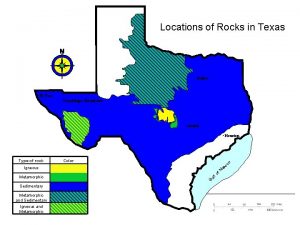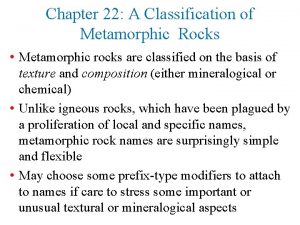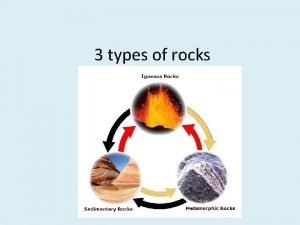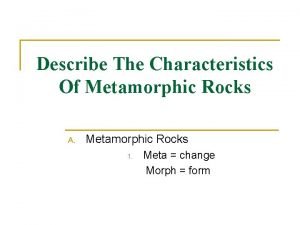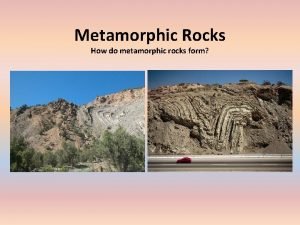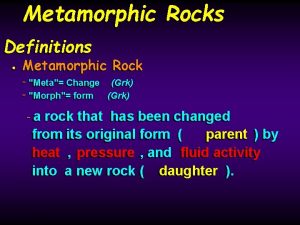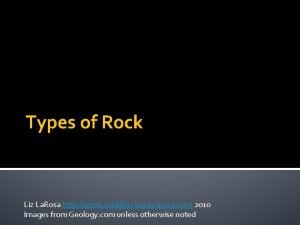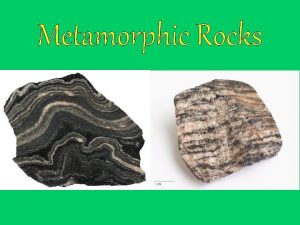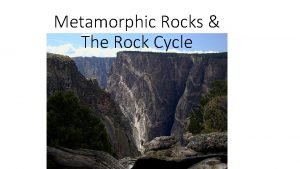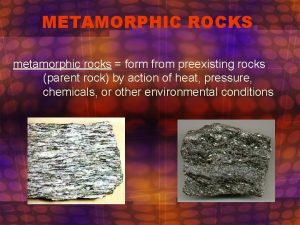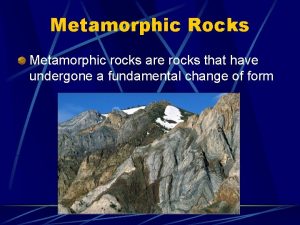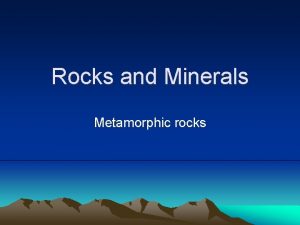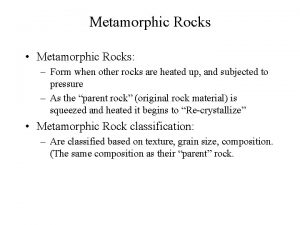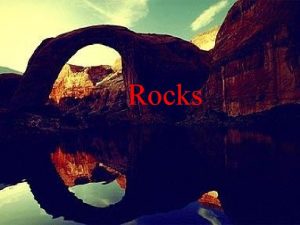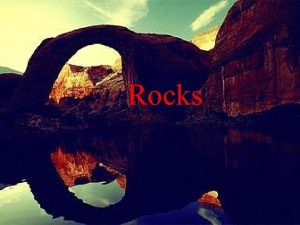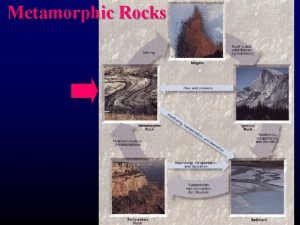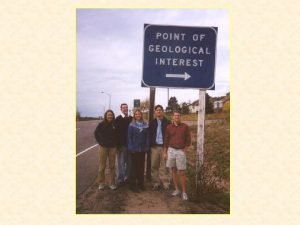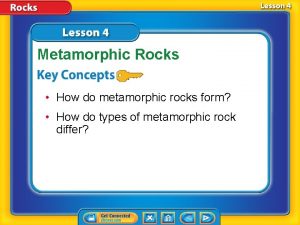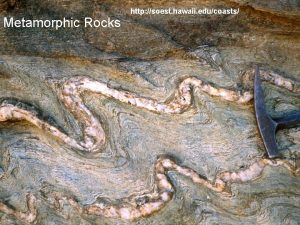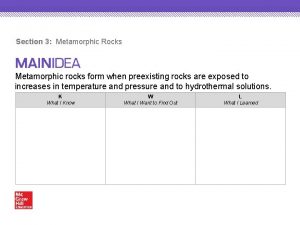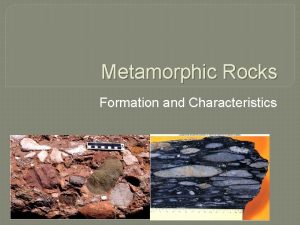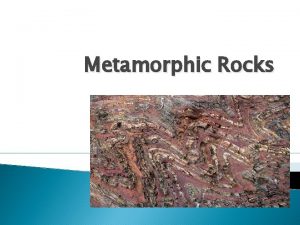3 Metamorphic rocks 10914 Metamorphic rocks are rocks
























- Slides: 24

3. Metamorphic rocks 10/9/14

Metamorphic rocks are rocks that have "morphed" into another kind of rock. These rocks were once igneous or sedimentary rocks. The rocks are under tons and tons of pressure, which fosters heat build up, and this causes them to change.

How are they formed? n Metamorphic rocks are pre-existing rocks that have been changed by heat and/or pressure without melting. n These pre-existing rocks are called parent rocks

Metamorphic rocks: Form from already existing rocks that have been changed by heat and pressure, without melting. What happens to rocks that are metamorphosed? 2. Atoms are squeezed together and the rock becomes more dense. Minerals line up in Bands. 3. Distortion (bending) of mineral alignment. 4. Minerals recrystallize (new minerals form). 1.

Classification n Foliated n Mineral crystals are aligned, or arranged in bands or layers. n Banding: High grade metamorphism. Alternating layers of dark and light minerals. n Non-foliated n Mineral crystals do not have mineral crystals arranged in bands of layers. Example marble and quartzite.

Foliated n 1. 2. 3. 4. Examples Slate Phyllite Schist Gneiss



Non-foliated n Examples n 1. Quartzite n 2. Marble n 3. Metaconglomerate n 4. Anthracite Coal n 5. Hornfels

Metamorphism n Regional Metamorphism n n n Caused by extreme pressure and heat. Happens over wide “regions”. Contact Metamorphism n Caused by contact with extreme heat.

Types of metamorphic rocks Schist These rocks can be formed from basalt, an igneous rock; shale, a sedimentary rock; or slate, a metamorphic rock. Through tremendous heat and pressure, these rocks were transformed into this new kind of rock.

Gneiss These rocks may have been granite, which is an igneous rock, but heat and pressure changed it. You can see how the mineral grains in the rock were flattened through tremendous heat and pressure and are arranged in alternating patterns.

Holey schist!



Lab Vocab n n Foliated metamorphic rocks: contain aligned grains of flat minerals Non-foliated metamorphic rocks- mineral grains are not aligned or bands Contact Metamorphism – rocks change when heated by nearby magma Regional Metamorphism- rocks change as pressure builds up from plate collision.



Rock Cycle n Rock must go through melting and solidification to become an igneous rock n Rock must go through weathering and erosion to become sedimentary rock n Rock must go through heat and pressure to become a metamorphic rock



Based on the characteristics, what kind of rock is A? B? C? D? E? Write the key word that led you to this conclusion.

What type of rock is each? A. B. C. D.

 Sedimentary rock song
Sedimentary rock song Igneous rock to metamorphic rock
Igneous rock to metamorphic rock Insidan region jh
Insidan region jh Metamorphic rocks
Metamorphic rocks Sedimentary rocks turn into metamorphic
Sedimentary rocks turn into metamorphic Metamorphic rock phase diagram
Metamorphic rock phase diagram Staurolite
Staurolite Rock cycle def
Rock cycle def Metamorphic rocks in texas
Metamorphic rocks in texas Importance of metamorphic rocks to man
Importance of metamorphic rocks to man Foliated definition
Foliated definition Venn diagram of contact and regional metamorphism
Venn diagram of contact and regional metamorphism Students found a metamorphic rock in the campsite
Students found a metamorphic rock in the campsite The formation of igneous rocks
The formation of igneous rocks How are metamorphic rocks classified
How are metamorphic rocks classified Metamorphic rocks properties
Metamorphic rocks properties Metamorphic rocks in michigan
Metamorphic rocks in michigan Metamorphic rocks with a layered or banded look are called
Metamorphic rocks with a layered or banded look are called Metamorphic rocks characteristics
Metamorphic rocks characteristics Metamorphic rocks
Metamorphic rocks Metamorphic rocks
Metamorphic rocks Characteristics of metamorphic rocks
Characteristics of metamorphic rocks Formation of metamorphic rocks
Formation of metamorphic rocks Metamorphic rocks
Metamorphic rocks Chapter 6 sedimentary and metamorphic rocks answer key
Chapter 6 sedimentary and metamorphic rocks answer key



